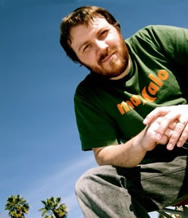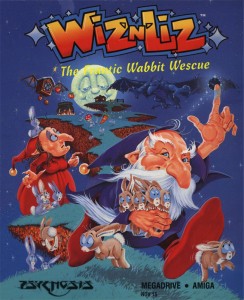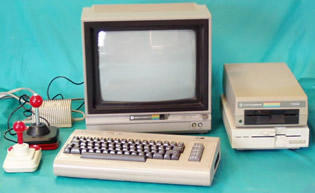Throughout the ’90s and the beginning of this decade, fewer sound artists were busier than Matt Furniss. With dozens of game soundtracks to his credit, he has been scoring  and doing sound effects for video games for platforms of all kinds, from Amiga and Spectrum to the Playstation and Windows. His work appears in some of the most famous games you’ve played, such as Alone in the Dark on the 3DO and Fear Effect on the Playstation.
and doing sound effects for video games for platforms of all kinds, from Amiga and Spectrum to the Playstation and Windows. His work appears in some of the most famous games you’ve played, such as Alone in the Dark on the 3DO and Fear Effect on the Playstation.
The Genesis, Furniss has a monumental repertoire. Responsible for composing soundtracks for some games and converting the scores of others, he has put his stamp on more games than you can shake a control pad at, including titles like Sensible Soccer, Chuck Rock, G-LOC: Air Battle, and T2: The Arcade Game.
Mr. Furniss was kind enough to take some time and chat with us about his long career.
Sega-16: How is your musical background? For example, why did you get into music and what instruments have you learned to play?
Matt Furniss: Nothing formal. From an early age I played keyboards, then later guitar. A little know fact – Someone once said I’m virtuoso on the harmonica, and that my rendition of “Moon River” renders the audience to tears. Now I just play bass guitar, when I have the time.
Sega-16: How come you started making music for video games?
Matt Furniss: I had to make the music, it’s the best part of the game isn’t it? Actually, it was early C64 games that really turned me on to VG audio. I always loved those Ocean tape loaders with the Martin Galway music. I’d listen to the music while the game loaded, then when it was done -I’d hit reset and start again. Really, I did that. But I only started writing my own music when I got an Atari ST, and then the Commodore Amiga.
Sega-16: What kind of equipment did you use when composing music?
Matt Furniss: For my Sega Genesis work I had a custom system. It was created by me and Shaun Hollingworth. Although Shaun really did most of the heavy lifting code-wise. The hardware was comprised of an Atari Mega ST and Sega Genesis/SNASM dev kit. Software was a tracker-type application running on the ST. I also had a few synthesizers, samplers, etc.
Sega-16: You worked a lot with Shaun Hollingworth, and your music used his sound engine on almost all of the Mega Drive games you worked on. Could you tell us a bit about your work relationship to him? Do you still know him? (Looking at your Facebook profile, it seems that you do!)
Matt Furniss: Shaun wrote most of the sound engines I used in the early years. He is quite a good pianist and has an ear for music, so he helped a lot when developing our audio systems. And of course, Shaun is a really good programmer too. We’re still friends and keep in touch.
Sega-16: What do you think about the Mega Drive sound chips? Were they easy to work with and did your results by working on them reach what you originally had in mind?
Matt Furniss: I really loved how the Mega Drive sounded. One of the first games I got for my Japanese import machine was The Super Shinobi. Totally amazing music by Yuzo Koshiro, that I think was not bettered for the entire life of the console.
I never found it hard to work with the hardware, I’d already been working with Yamaha FM sound chips on the PC AdLib and SoundBlaster cards -Sega Mega Drive was quite similar.
Sega-16: Actually, there was another lad interviewed for Sega-16 who said the exact same about the Super Shinobi soundtrack being the best, even though it came so early in the Mega Drive’s life span! What other soundtracks of the time impressed you, and maybe introduced new elements to video game music?
Matt Furniss: Some other Mega Drive game audio I liked: Midnight Resistance, Gauntlet IV, Batman (Sunsoft), Streets of Rage, Castle of Illusion.
 Sega-16: The Mega Drive has a moderately big homebrew scene today, with many composers making Mega Drive compatible music for their own. Do you have any tips for them, so they can make most possible out of the hardware?
Sega-16: The Mega Drive has a moderately big homebrew scene today, with many composers making Mega Drive compatible music for their own. Do you have any tips for them, so they can make most possible out of the hardware?
Matt Furniss: I don’t think I was doing anything that “special” with the hardware. Just six channels of 4-OP FM, or 5 + PCM. In fact, I never utilized the AY sound hardware. So the homebrew guys have more to work with than I had. Tips? Make use of all audio channels all the time. Use any spare channel space for fake reverbs, stereo chorus effects, etc. Use
samples for snares and kicks, FM for hats, toms, etc. If you need more channels, try a few old-school techniques like fast arpeggios for chords -as were common on the C64.
Sega-16: It was common to do as you did, using only FM for music leaving PSG for sound effects. Could you tell us about the creation of sound effects? Like, in practice, what do you actually do when not using samples?
Matt Furniss: Our system just used a single FM track and/or PCM channel. Very basic actually.
Sega-16: Comparing soundtracks such as those to the games of T2: The Arcade Game, Wiz ‘n’ Liz and The Lost Vikings for example show you had very versatile composing skills. Did you have any special schooling for it or is it natural talent?
Matt Furniss: Definitely no special schooling. I got my first job writing video game audio just after I left school at age sixteen. That was 1989, the same year the Sega Genesis was released. We had our first Genesis sound driver complete in 1990, so I was in from the start and able to get lots of audio work for development houses in the UK and USA.
Sega-16: Wiz ‘n’ Liz is a favourite of mine, and its soundtrack fits the game like a hand in a glove. It is also a game where the Amiga soundtrack is different to the Mega Drive soundtrack. Could you tell us about the development of this game?
Matt Furniss: Thanks! Wiz ‘n’ Liz is one of my favorite soundtracks too. Psygnosis contracted me to write the music for a new game being developed by Martyn Chudley at Bizarre Creations. It was a perfect match. The game was quite experimental and I was still experimenting with the YM2612. I had free-reign to do anything I wanted, and lots of ROM space. The Amiga soundtrack is based on my Sega Genesis soundtrack, it was converted by Psygnosis’ in-house musician, Rik Ede.
Sega-16: Hearing the Amiga soundtrack for Wiz ‘n’ Liz, it’s apparent it is the conversion since there are many “holes” in the sound compared to the Mega Drive version. On the other hand, the Mega Drive could not reproduce the ambient samples of the famous Shadow of the Beast. On some of the soundtracks which are both on Amiga and Mega Drive, many tunes are completely different depending on hardware. Was this something you needed to do because converting the tunes didn’t fit the different sound hardware, or did you just prefer to compose new tunes?
Matt Furniss: If I liked the original music, I’d convert it faithfully. Some examples from the Amiga would be Chuck Rock II, Leander/Galahad, Mr Nuts. And then other times, the Amiga music wasn’t that great -so I’d compose new music better suited to the Mega Drive’s audio hardware. (Ed. note: Matt pliably evades giving any examples of Amiga music that “wasn’t that great…“)
Sega-16: How much ROM space were you usually given to work with on the 4 and 8mb cartridge games? Did you usually think this was enough, or did you have to compromise with quality to save space often?
Matt Furniss: Generally up to 128 kbytes for all the music, effects, samples and driver. Enough for me! 😉
Sega-16: How was it different in making soundtracks for the 16-bit games compared to the 32 and 64-bit games?
Matt Furniss: Huge. 16-bit was all about making something sound great with the very limited hardware. With 32-bit consoles came CD-ROM audio -and you can pretty much do anything. That was never as fun for me.
Sega-16: So, like many other artists have said, limitations help creativity? Do you have some trivial example of that? Perhaps the use of FM let you experiment with completely new sounds while PCM chips only reproduced old sounds?
Matt Furniss: Sure. Check out my music for The Second Samurai. It’s very “FM.” Lots of big sweeping synths and FM tricks.
Sega-16: Seeing your entry on Wikipedia, it seems like you stopped making video game music around 2001. What have you done since then and what are you doing today?
Matt Furniss: Around 2001 I went into software engineering and web development full time. Web apps for Health Insurance and Online Advertising. But I’m actually just about to get back into games -in a way, not music though.
Over the last few years I’ve done a bit of retro-demo work for Ate Bit. It’s all Yamaha AY-3-8912 based. Check out our page.
 Sega-16: You’ve really done some amazing stuff with the Speccy and the C64. Those, what should I say… “exploding pixelated paintballs” in the end of “Bad Scene Poets are Back” amazed me. Does this demo group have any bigger plans? Would you make more music for other old formats if given the opportunity? I’m sure Sega homebrewers would kill to have you write a tune or two.
Sega-16: You’ve really done some amazing stuff with the Speccy and the C64. Those, what should I say… “exploding pixelated paintballs” in the end of “Bad Scene Poets are Back” amazed me. Does this demo group have any bigger plans? Would you make more music for other old formats if given the opportunity? I’m sure Sega homebrewers would kill to have you write a tune or two.
Matt Furniss: I didn’t do the C64 music for that demo. My work for “Ate Bit” is all Spectrum: “Pimp my Spectrum,” some songs for “Pimp my Chips” and Sundown ’06 Invite. Sure I’d do some more Mega Drive music, though I have very limited time to write it.
We’d like to thank Mr. Matt Furniss for taking his time with this interview and wish him luck for his future efforts, whether it’s software engineering or music for retro video games!

Recent Comments